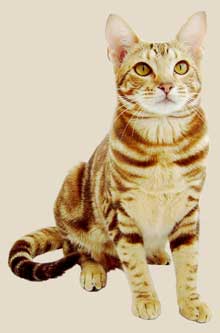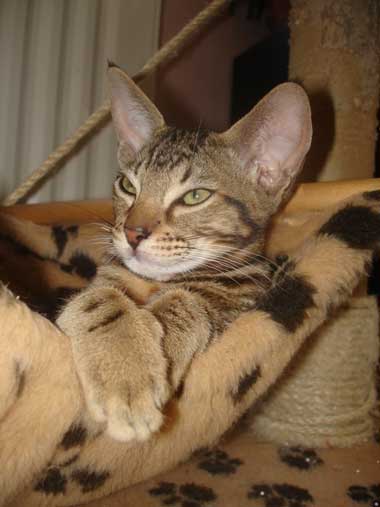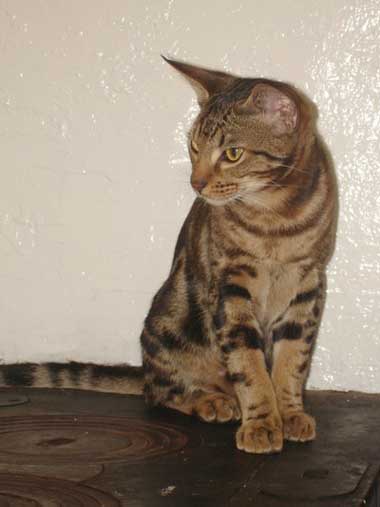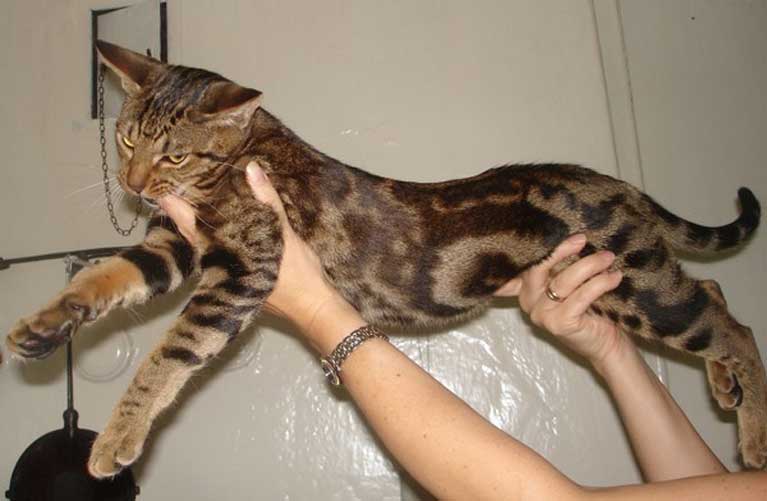The Ocicat Classic
The Ocicat Classic (or Classic Ocicat) differs from the Ocicat as it exhibits the stunning classic coat pattern rather than being spotted. These cats differ solely in the pattern; type, temperament and possible colours will be identical to the spotted Ocicat. Having the same athletic prowess, the classic pattern offers an alternative 'wild' look, while still providing the wonderful temperament, friendliness and intelligence that the Ocicat is renowned for.
The Abyssinian and the Siamese were the two foundation breeds used to develop the beautiful spotted Ocicat, but when the breed was recognised in America, the American Shorthair breed (ASH) was allowed to be used in the further development of the Ocicat. The American Shorthair added substance and size to the Ocicat, as well as introducing the silver gene and the classic pattern. This varied genetic mix has made the Ocicat what it is today. The classic pattern can be truly magnificent, being adorned with striking whorls and oyster markings (also commonly known as bulls eye pattern or blotched classic pattern).
The classic pattern on the Ocicat type results in a very striking cat indeed. The Ocicat has both the build and coat texture to show the pattern extremely well. The individual hairs are banded (agouti), and it is how the banding lies together that forms the pattern you see. Ideally the pattern is symmetrical on both sides of the cat. There should be oyster marks or blotches on the flanks and a butterfly shape on the shoulders. The contrast should be as clear and crisp as possible to make the pattern truly outstanding. They should have the same tabby facial markings as the spotted Ocicat, with the tabby 'M' frown markings above the eyes. The Classic pattern can occur in all of the 12 beautiful Ocicat colours.
 The Classic pattern has been valued around the world in breeding programs, as it is believed that carrying just one classic gene can improve the pattern and definition in any spotted Ocicat. As the gene for the classic pattern has been integral to the Ocicat since the breed’s origins, it is commonly held that if this gene is carried it can influence the spotting pattern, giving a 'whorled' pattern of spots around a central spot, resulting in a good clear 'bulls eye' of spots on the flank. The Classic pattern has been valued around the world in breeding programs, as it is believed that carrying just one classic gene can improve the pattern and definition in any spotted Ocicat. As the gene for the classic pattern has been integral to the Ocicat since the breed’s origins, it is commonly held that if this gene is carried it can influence the spotting pattern, giving a 'whorled' pattern of spots around a central spot, resulting in a good clear 'bulls eye' of spots on the flank.
The classic pattern has already been granted recognition in New Zealand under the names Classicat and Jungala. They have been recognised as a new breed rather than a new pattern, to allow the Ocicat to retain its spotted status. The breeding policy permits the breeding of Classicats or Jungalas with the Ocicat, from which you could expect a mixture of classic and spotted kittens, the kittens are then registered to the breed appropriate for their pattern.
Until late 2008 the Ocicat Classics could be registered and used in breeding programs in the UK, but could not be shown in competition as Ocicats, due to their lack of spots!
To read how the Ocicat Classic became a new breed in the UK, please see below!
The Ocicat Classic as a New Breed
During 2008 an application for New Breed Status was submitted to the GCCF. This application requested that the Classic patterned Ocicats were recognised as a New Breed under the name Ocicat Classic*. Prior to this a seminar was held to officially present the Ocicat Classic, they were very well received and interest was high among breeders and judges alike. The name of Ocicat Classic has been granted by GCCF, along with the Breed Number of 73 41. The granting of a breed name and breed number does not mean that the breed will automatically be accepted, but does give a name and number with which to register any kittens fitting the description of an Ocicat Classic. Any cat registered as an Ocicat Classic under the new breed number will be able to be shown in competition for Merit Certificates if approval is granted.
The application had to go through several stages of approval with GCCF before the Ocicat Classic was officially recognised, it has currently been granted the first stage of recognition. This means we are at a very exciting juncture, hopeful that the new breed will flourish along side the Ocicat!
*The application for 'New breed' status for the Ocicat Classic means the status of the Ocicat is unaffected. The Ocicat is a spotted breed by definition, and will remain so!
Preliminary Recogniton was granted for the Ocicat Classic breed at the Council meeting of the GCCF on the 29th October 2008! The breed can now be shown in competition for Merit certificates as soon as showmangers can enter the classes in their show schedules.
The Ocicat Classic was represented at their first ever show in the UK on 10th january 2009
Our Ocicat Classic Stud 'Neo'
S*MARBLE & SILK'S N. TIRAMISÚ
We are very proud to introduce our new Ocicat Classic Stud boy 'Neo'!
His registered name is S*Marble & Silk´s N. Tiramisú (the N. is for Neo!), he is a Tawny Ocicat Classic, who arrived on 21st January 2009 from Sweden. We are very grateful to his breeder, Pernilla Hansson, for entrusting us with one of her beautiful boys. Pernilla has been very supportive of the recognition being sought for the Ocicat Classic in the UK, and we are sure her boy will make her proud!
Neo arrived in the UK a confident and happy young man, barely seeming to notice that he had just spent almost an entire day either on the road or in the air just to get here! He settled almost instantly, and has shown himself to have a very loving and sweet nature. With such a wonderful temperament, we have every confidence that he will produce some beautiful and lovely natured kittens.
We hope Neo will play his part in the foundation of the Ocicat Classic in the UK, allowing us to provide a broader genetic base on which to establish our own breeding program.
Thank you to Pernilla for these lovely pictures!

 
Left: Will he ever grow into those HUGE paws!? Right: Maturing and developing a really wild look

He is just 6 months old here and clearly still has a lot of growing to do, as his paws are still too big for him!
|